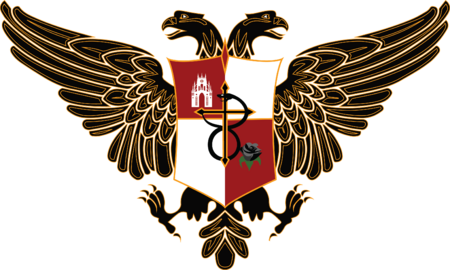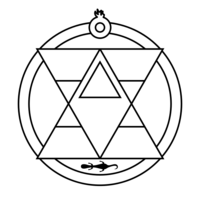Chymetics: Difference between revisions
No edit summary |
|||
| (2 intermediate revisions by 2 users not shown) | |||
| Line 1: | Line 1: | ||
[[File:Chymetic College.png|thumb|right|upright= | [[File:Chymetic College.png|thumb|right|upright=1.5|Seal of the [[Imperial & Federal Grand College of Chymetics]] ]]'''Chymetics''' is a branch of science concerned with the manipulation of the Aether, an alternate dimension filled with an energy rich miasma. Chymetics focuses on how this material reacts, and how it can be utilised within realspace to fulfil various functions. More broadly, chymetics also concerns itself with metaphysical analysis on the nature of the Aether, and its relationship to realspace. | ||
Chymetics | Chymetics was first seen in the hands of the Centri, an alien race that inhabited worlds near Gerstintor in what is now the Imperial Main. Originally, the usage of chymetics by the Centri was seen as an application of unknown technologies, and after the Eriandorian Cataclysm at the conclusion of the Fae War in 356 P.L., little attention was paid to these mysterious alien technologies. The establishment of the Guild of Chymeticists on Spitzesland by Sir Rodrick von Goytz in 610 P.L. marked the beginning of modern chymetic study. Chymetics did not truly become the driving force of the R.u.B Union until 'the Promised Day' of 648 P.L., which saw von Goytz killed and many worlds in former Centri space lost. | ||
After this, chymetic technology rapidly advanced, and became integral to the development and expansion of the R.u.B Union beyond the Imperial Main and into the Aquila Cluster at large. | |||
==History== | ==History== | ||
Latest revision as of 09:34, 18 May 2019

Chymetics is a branch of science concerned with the manipulation of the Aether, an alternate dimension filled with an energy rich miasma. Chymetics focuses on how this material reacts, and how it can be utilised within realspace to fulfil various functions. More broadly, chymetics also concerns itself with metaphysical analysis on the nature of the Aether, and its relationship to realspace.
Chymetics was first seen in the hands of the Centri, an alien race that inhabited worlds near Gerstintor in what is now the Imperial Main. Originally, the usage of chymetics by the Centri was seen as an application of unknown technologies, and after the Eriandorian Cataclysm at the conclusion of the Fae War in 356 P.L., little attention was paid to these mysterious alien technologies. The establishment of the Guild of Chymeticists on Spitzesland by Sir Rodrick von Goytz in 610 P.L. marked the beginning of modern chymetic study. Chymetics did not truly become the driving force of the R.u.B Union until 'the Promised Day' of 648 P.L., which saw von Goytz killed and many worlds in former Centri space lost.
After this, chymetic technology rapidly advanced, and became integral to the development and expansion of the R.u.B Union beyond the Imperial Main and into the Aquila Cluster at large.
History
Roots
Foundation of the College
The Promised Day
Contemporary History
The Aether
The aether (also known as the Gallenic Sea) is an alternate dimension of energetic material that underlies and echoes the more conventional four dimensions of real space. The aether consists of an energetic substance known as 'miasma', and it is the energy drawn from the aether that provides the basis for all chymetic technologies that underpin key aspects of the Chymetic States. The aether and the way it interacts with realspace, is best viewed as a great ocean of miasma, with worlds and other points of interest spread through it like islands. Much like an ocean, the aether has currents and tides that make it easier to travel between different islands, storms that can disrupt travel between the islands, and tides or waves that can lap onto the shore of these islands of real space and leave them changed. Learning to harness and control these interactions between the aether and realspace is the core of chymetics. These interactions of the aether with realspace can manifest in a wide variety of ways, and provides the basis for all chymetic technologies.
The level of interaction the aether can have with real space varies. To continue the ocean metaphor, some islands are placed atop towering bluffs where the waves and storms of the sea can hardly even reach them, while others are low and open to being swept up by the tides of miasma. These interactions between the aether and realspace can result in a wide variety of formations, or even be artificially controlled. The ability to control and direct the tides of the aether is a vital ability taught by all Chymetic Academies, and can result in a surprisingly divergent array of abilities and outcomes. These can be analogised as dipping a watermill into the aether, or crafting a channel through which it can flow. The boundary between the aether and realspace can vary in its resilience, and shifting tides of forces in the aether can disrupt connections to realspace.
The miasma that makes up the aether can not normally exist in realspace, and will tend to decay rapidly and energetically if brought into realspace. As such, it must either be converted into a form more suitable for realspace, or disposed of quickly before it can do much damage. The miasmic exhaust from the processing or utilisation of chymetic engines or other technologies is a great concern. However, if it is able to disperse, it is relatively harmless. Nonetheless, the amount of power utilised by chymetic technology is astounding, and--if not properly controlled--can result in serious harm to the user, and those surrounding them. There are also tales amongst voidsman and chymeticists is that--like the deepest reaches of a standard world's oceans--creatures dwell within the aether; strange creatures distinct from more common forms of life, which prey upon unsuspecting visitors from realspace and even seek to escape the aether. However, such rumors have never been substantiated and are widely believed to be nothing more than superstition.
Ley Lines
Ley Lines are one of the most important aspects of chymetic studies. The Gallenic Sea is vast beyond imagining, but much of it is locked beyond the reach of even the most experience chymeticists. Ley lines are areas within real space where the aether presses close enough to real space that it can interact with realspace in a multitude of ways, and can be easily accessed. Ley lines are vital to travel in the aether, as well as most other aspects of chymetics.
Chymetically, ley lines are a web of interconnected area and corridors where the aether lies particularly close to realspace, and where access to the aether is possible given current technology. Ley lines are vital for most current uses of chymetic technology, as ships utilising transition drives are only able to travel along ley lines, and so must hop from line to line in order to make complete journeys. Where ley lines intersect bodies in real space, like worlds, moons, and asteroids, condensations can form as the aether influences and solidifies into real space. Ley lines can be disrupted by clouds and other aetheric phenomenon, and can also shift positions over time. Modern chymetic studies allows for the manipulation and limited 'forging' of ley lines, but are still closely tied to 'natural' lines for most activities. Ley lines can vary in intensity, and are often ranked as such. Higher intensity ley lines can allow for faster travel, and more prominent or intense condensation deposits along their length.
The terminal points of ley lines (commonly termed tellurii) are often areas of particular concern, as the barriers between aether and real space are particularly thin at such points. More importantly, telurii are usually stable, and do not shift location as much as the majority of the line. As such, they tend to become particularly important locations for a wide variety of purposes. Often, telurii mark the location of particular rich condensation deposits, or an area well suited for entering into transition travel. As such, they are of great importance in terms of economic and military activity.
Condensations
Main Article: Chymetic Condensations
Condensations are realspace materials which have been altered and changed by interaction with the aether. Condensations form in locations where ley lines either flow through or terminate on an object in realspace, with the result of continuously bathing and showering the area with energy from the aether. This has the effect of creating a 'deposit' of chymetic energy in realspace, altering the material composition of the area where it exists, thus creating condensations. Condensations can exist for an extensive time, as chymetic materials decay very slowly--if at all--with the result that slowly wandering ley lines can create extensive condensation deposits, or that condensation deposits can exist where no ley lines have been known to exist. Condensations can form almost anywhere a ley line can, and so can form on the surface or interiors of worlds, moons, and asteroids. Condensation deposits have been found in gaseous bodies as well, including gas giants and nebulae. Although a chymetic star has been theorised to exist, no known example of such an object has been discovered.
Condensations provide one of the most economically viable means of utilising chymetic technology. Mining of condensations in various forms have become a major economic activity within the chymetic states, and the presence of proper condensation deposits can be a vital consideration for colonisation. Worlds with high concentrations of condensations are also often a nexus of multiple high intensity ley lines, making them particularly key worlds to control for administrative, economic, and military reasons. Condensations--once collected--can be formed into any number of useful materials, with uses found in all aspects of civilisation, including energy generation, travel, construction materials, armour, and a wide variety of other technologies.
Condensations come in a wide variety of forms, depending on what form of matter the ley line interacted with while creating the desposit. The most important divide in condensations is how the condensate can be 'activated' and utilised. Some materials like mithril, phlogiston, coronatite, cavorite, and orichalcum can be activated and utilised via conventional means, without the intervention of a trained chymeticist. Termed standard materials, these condensations provide the primary baseline However, other materials, like flanelite, adamanatium, alkahest, and others are only able to be utilised by a trained chymeticist, usually through the form of a conduit.
Conduits
Applications
Power Generation
Materials
Transition Travel
Main Article: FTL Travel in the Imperial & Federal Union
Weaponry
Thaumaturgy
Thaumaturgy is the overarching term for the direct utilisation of the aether, and a direct manifestation of the aether's power in realspace. Thaumaturgy is distinct from the use of condensates, as those materials rely either on their unique structures crafted by exposure to the aether, or in long term deposits of energy over time, whereas thaumaturgy involves a real-time, immediate use of aetheric energy. In addition, while many condensates and transition travel can be performed with convention, non-chymetic means, thaumaturgy requires a trained chymeticist to operate.
